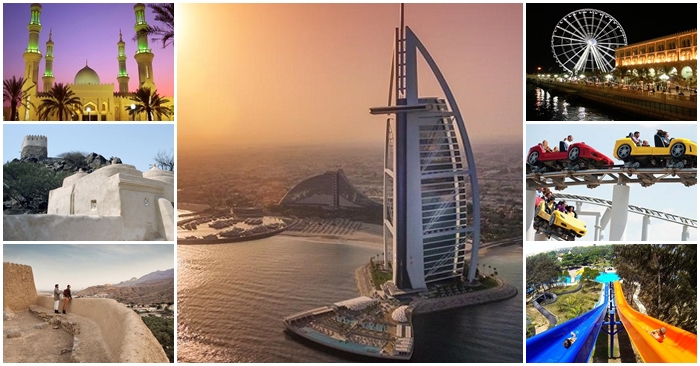The Top 8 Historical Places To Visit In Abu Dhabi
Abu Dhabi, the capital of the United Arab Emirates, is not only a bustling modern metropolis but also a treasure trove of historical sites that offer a glimpse into the rich tapestry of Arab history and culture. From ancient forts and palaces to grand mosques and traditional villages, Abu Dhabi is a city that proudly preserves its heritage while embracing the future.

Discovering Abu Dhabi's Rich Heritage
Abu Dhabi’s historical attractions provide a deep insight into the emirate's transformation from a modest fishing village to a global city of significance. These sites not only tell the story of a bygone era but also highlight the traditional Arabian craftsmanship and Islamic architectural brilliance.
Why Visit Historical Sites in Abu Dhabi?
Visiting these sites allows you to experience the authentic culture of the UAE, learn about the region's history, and see the incredible art and architecture up close. Each site offers a unique story and a distinct glimpse into the Emirati way of life, making them must-visit destinations for history buffs and curious travelers alike.
Qasr Al Hosn
The Story of Qasr Al Hosn
Qasr Al Hosn, known as the White Fort or Old Fort, is the oldest stone building in Abu Dhabi. Originally constructed in 1761 as a conical watchtower to protect the only freshwater well in Abu Dhabi Island, it was later expanded into a small fort in 1793 and then into a full-fledged palace in the late 19th century. This historic building has been the residence of the ruling family, the seat of government, the consultative council, and the national archives.
Visiting Qasr Al Hosn: What to Expect
Today, Qasr Al Hosn is a museum that showcases the history and culture of Abu Dhabi, with exhibitions that display artefacts and photographs from the emirate's past. The fort itself is a stunning example of Arabian architecture, with its iconic white walls and majestic interior.
Architectural Highlights of Qasr Al Hosn
The architecture of Qasr Al Hosn is a blend of traditional Arabian design with modern influences. The interior of the fort is adorned with intricate tile work and plaster, while the exterior is marked by its high walls and traditional wooden windows. The fort's large courtyard is a place of tranquility, away from the hustle and bustle of the city.
Events and Exhibitions at Qasr Al Hosn
Qasr Al Hosn hosts a variety of cultural events and exhibitions throughout the year, including the annual Qasr Al Hosn Festival, which celebrates the UAE's heritage with workshops, performances, and demonstrations.
Al Jahili Fort
The Historical Importance of Al Jahili Fort
Built in 1891 to defend the city and protect precious palm groves, Al Jahili Fort is one of the UAE's most historic buildings. It was a royal summer residence and a strategic fortification for the protection of the region’s mountain passes.

Exploring Al Jahili Fort: A Visitor's Guide
Today, the fort is open to the public and offers a peek into the past with its exhibitions and beautifully landscaped gardens. Visitors can explore the interior of the fort, see old photographs and maps, and learn about the fort's history and the people who lived there.
The Architecture and Design of Al Jahili Fort
The fort's design reflects traditional Emirati architecture, with thick walls made of mud bricks and a central courtyard that keeps the interior cool. The watchtowers offer panoramic views of the surrounding landscape.
Activities and Tours Available at Al Jahili Fort
Visitors can enjoy guided tours of the fort, which include insights into the lifestyle of the early inhabitants and the history of the region. The fort also hosts temporary exhibitions and cultural events that bring the history of the region to life.
Heritage Village
A Glimpse into Traditional Emirati Life
Heritage Village is a reconstruction of a traditional oasis village that provides an insight into the desert way of life before oil discovery. The village features a souk, a mosque, and typical Arabian houses made from mud-brick and palm thatch.
What to See and Do at Heritage Village
Visitors to Heritage Village can watch craftsmen demonstrate traditional skills such as metal work, pottery, weaving, and spinning. The village also has a small spice shop where traditional herbs and spices are sold.
Cultural Demonstrations and Crafts at Heritage Village
The craftsmen at Heritage Village are happy to share their knowledge and skills with visitors, making this a great place to learn about local crafts and traditions. The demonstrations provide a deeper understanding of the ingenuity and skill involved in traditional Emirati crafts.
The Best Time to Visit Heritage Village
The best time to visit Heritage Village is during the cooler months from November to March when the weather is pleasant, making it easier to explore the outdoor areas and enjoy the cultural demonstrations.
Al Maqtaa Fort
The Legacy of Al Maqtaa Fort
Al Maqtaa Fort, built in the late 18th century, was once a vital watchtower that guarded the approach to the island city from the mainland. Positioned at the end of the Maqta Bridge, this fort is a fine example of old Emirati defensive architecture.
How to Experience Al Maqtaa Fort
Although smaller than some of Abu Dhabi’s other forts, Al Maqtaa Fort offers visitors a sense of the strategic importance of these structures. The fort overlooks the Maqta Creek, and its restored interiors display traditional weapons and artifacts.

The Structure and Significance of Al Maqtaa Fort
The fort's structure is typical of the period, with high walls and a central courtyard. The watchtowers provide a commanding view of the surrounding area, demonstrating its strategic importance in the defense of Abu Dhabi.
Nearby Attractions and Dining Options
Close to Al Maqtaa Fort are several dining options where visitors can enjoy local and international cuisine. The nearby Sheikh Zayed Grand Mosque is another must-visit attraction, providing a contrast between the old and new in Abu Dhabi.
The Sheikh Zayed Grand Mosque
A Marvel of Modern Islamic Architecture
The Sheikh Zayed Grand Mosque is one of the world’s largest mosques and a massive architectural work of art that intentionally blends different Islamic architectural schools. It features 82 domes, over 1,000 columns, 24 carat gold gilded chandeliers, and the world's largest hand-knotted carpet.
Tips for Visiting the Sheikh Zayed Grand Mosque
The mosque is open to visitors of all faiths, and tours are a great way to learn about the architecture, the Islamic culture, and the mosque’s role in the community. Visitors should dress modestly, covering arms, legs, and hair, when visiting the mosque.
Understanding the Mosque's Design and Art
The mosque’s design uses marble, gold, semi-precious stones, crystals, and ceramics. It was designed by British, Italian, and Emirati architects and took over a decade to complete. The mosque’s key elements include the world’s largest loom-knotted carpet and one of the largest chandeliers in the world.
Guided Tours and Spiritual Insights
Guided tours of the mosque include visits to the main prayer hall, library, and outer gardens. The tours provide insights into the spiritual aspects of the mosque and the Islamic faith, making this an enriching experience for all visitors.
Qasr Al Muwaiji
The Historical Significance of Qasr Al Muwaiji
Qasr Al Muwaiji is an impressive structure that has been the home and administrative seat for the Al Nahyan family. The fort’s history dates back to the early 20th century and played a part in the history of Abu Dhabi.
Activities and Exhibits at Qasr Al Muwaiji
The fort is now a museum that chronicles the history of the region, and particularly the life of His Highness Sheikh Khalifa Bin Zayed Al Nahyan. The exhibitions offer a fascinating glimpse into the fort's past and the history of the ruling family.
The Restoration Efforts and Their Impact
The recent restoration of Qasr Al Muwaiji has turned it into a state-of-the-art museum that blends the old with the new. The restoration work has preserved the original structure of the fort while adding modern elements that enhance the visitor experience.

Planning Your Visit to Qasr Al Muwaiji
The museum offers a range of interactive displays and educational programs, making it a great place to learn about the history of Abu Dhabi and the United Arab Emirates. The fort is open to the public, and guided tours are available.
Abu Dhabi Falcon Hospital
The Role of Falcons in Emirati Culture
The falcon is an important symbol of the Emirati heritage and a key element of desert life. The Abu Dhabi Falcon Hospital is the world’s largest and most advanced falcon hospital, dedicated to the care and preservation of these majestic birds.
A Unique Tour Experience at Abu Dhabi Falcon Hospital
Visitors to the hospital can take a guided tour to see the falcons up close, learn about the traditional art of falconry, and see the expert care that the birds receive. The tour includes a visit to the examination room and the free-flight aviary.
Falconry Demonstrations and Conservation Efforts
The hospital conducts regular falconry demonstrations, where visitors can see the falcons in flight and learn about the traditional hunting techniques. The hospital is also involved in conservation efforts to protect wild falcon populations.
Visitor Information and Hospital Features
The hospital features state-of-the-art facilities, including a falcon museum, a specialty falconry pharmacy, and a souk where visitors can buy traditional falconry equipment and souvenirs.
Bait Al Oud
Preserving the Musical Heritage of the UAE
Bait Al Oud is a music academy in Abu Dhabi that is dedicated to preserving the traditional music of the UAE, including the art of playing the oud and other Arabic instruments. The academy offers classes and workshops for students of all ages and abilities.
Visiting Bait Al Oud: What You Need to Know
The academy hosts regular concerts and recitals, showcasing the talents of its students and faculty. Visitors can attend these performances to experience the traditional music of the UAE and learn about the instruments used.
Musical Performances and Learning at Bait Al Oud
In addition to concerts, Bait Al Oud offers workshops and lectures on the history and technique of Arabic music. These sessions provide a deeper understanding of the cultural significance of music in Emirati society.
The Architecture and Atmosphere of Bait Al Oud
The architecture of Bait Al Oud is a blend of traditional and modern design, creating a serene and inspiring environment for learning and performing music. The peaceful surroundings and beautiful design make it a wonderful place to experience the soothing sounds of Arabic music.
What is the best time of year to visit these historical sites in Abu Dhabi?
The best time to visit Abu Dhabi's historical sites is from November to March, when the weather is cooler and more comfortable for exploring outdoors.
Are there any entry fees for these historical sites?
Some of Abu Dhabi's historical sites, like Qasr Al Hosn and Sheikh Zayed Grand Mosque, are free to enter, while others may have a small entry fee. It's best to check the official websites for the most up-to-date information.
How can I respect local culture and traditions while visiting these sites?
Visitors should dress modestly, covering shoulders, knees, and hair when necessary. It's also important to be respectful of local customs and traditions, especially during religious observations.
Can I take photos inside these historical sites?
Photography is allowed in most areas, but some sites may have restrictions on taking photos of certain exhibits or interiors. Always look for signage or ask a guide if you are unsure.
Are guided tours available at these sites?
Yes, many of Abu Dhabi’s historical sites offer guided tours in various languages. These tours are a great way to learn about the history and significance of each site.
How accessible are these historical sites for visitors with disabilities?Many of Abu Dhabi's historical sites are accessible to visitors with disabilities, with ramps, lifts, and other facilities in place. However, it's a good idea to check in advance if you have specific needs.
Direct BookingReflecting on Abu Dhabi's Historical Journey
Abu Dhabi’s historical sites are not just relics of the past; they are living testimonies to the emirate’s commitment to preserving its heritage. Each site offers a unique story and an insight into the rich cultural tapestry of the UAE.Planning Your Next Visit to These Heritage Sites
Whether you are a history enthusiast, a cultural explorer, or simply looking for a unique travel experience, Abu Dhabi’s historical places are sure to enchant and inspire you. Plan your visit and step back in time to discover the stories that have shaped this vibrant city


